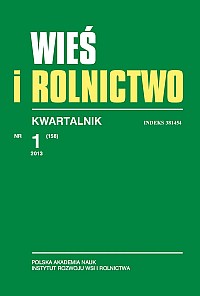Wskaźniki zrównoważonego rozwoju rolnictwa. Przesłanki teoretyczne i propozycja pomiaru w regionach UE
Indicators for sustainable development of agriculture. Theoretical premises and proposed measurement in regions of the EU
Author(s): Anna MatuszczakSubject(s): Economy
Published by: Instytut Rozwoju Wsi i Rolnictwa Polskiej Akademii Nauk
Keywords: sustainable development; agriculture; indicators; rozwój zrównoważony; rolnictwo; wskaźniki
Summary/Abstract: The article pointed out the desirability of considering sustainable development of agricultural at regional level. Against the backdrop of the agrarian economy assumptions, presents an approach to the concept of sustainable development, referring to the relationship between the orders of cohesion (economic, social and environmental), sustainable development and integrated order. Overview formed the theoretical basis for the operationalization of the measurement of sustainable development of agriculture in the EU regions. Based on FADN data for the average farm in the EU region (or the type of production or economic power) proposes to construct a synthetic indicator of the development of agriculture of these regions using the Hellwig’s method. Then the linear ordering allows the isolation of European regions, where agriculture will be considered: sustainable, medium or high unsustainable. W artykule wskazano na celowość rozważania zrównoważonego rozwoju rolnictwa na poziomie regionalnym. Mając w tle założenia ekonomii agrarnej, ukazano podejście do koncepcji rozwoju zrównoważonego, odnosząc się do relacji spójności pomiędzy ładem ekonomicznym, społecznym i środowiskowym, rozwojem zrównoważonym oraz ładem zintegrowanym. Przegląd teoretyczny stał się jednocześnie bazą do operacjonalizacji pomiaru zrównoważonego rozwoju rolnictwa w regionach UE. Bazując na danych FADN dotyczących przeciętnego gospodarstwa rolnego w regionie UE (bądź też jego typie produkcyjnym czy sile ekonomicznej), zaproponowano skonstruowanie syntetycznego wskaźnika rozwoju rolnictwa na poziomie wspomnianych regionów, stosując metodę Hellwiga. Stworzenie wskaźnika syntetycznego wynika z przesłanek merytorycznych (nagromadzonej wiedzy) oraz ewentualnie z danych dostępnych w FADN. Następnie porządkowanie liniowe pozwoli na wyodrębnienie regionów europejskich, gdzie rolnictwo będzie można uznać za zrównoważone, średnio niezrównoważone bądź wysoko niezrównoważone.
Journal: Wieś i Rolnictwo
- Issue Year: 158/2013
- Issue No: 1
- Page Range: 101-119
- Page Count: 19
- Language: Polish

